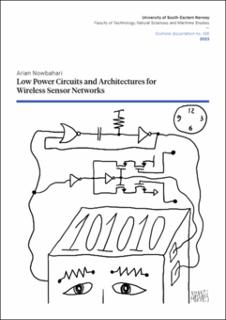| dc.contributor.author | Nowbahari, Arian | |
| dc.date.accessioned | 2023-05-30T14:00:46Z | |
| dc.date.available | 2023-05-30T14:00:46Z | |
| dc.date.issued | 2023 | |
| dc.identifier.isbn | 978-82-7206-779-2 | |
| dc.identifier.issn | 2535-5252 | |
| dc.identifier.uri | https://hdl.handle.net/11250/3069360 | |
| dc.description.abstract | Wireless sensor networks (WSNs), due to their multidisciplinary applications, represent one of the main enabling technologies of the Internet-of-Things paradigm. These networks, consisting of sensor nodes characterized by processing and transmitting capabilities, are implemented in various fields such as oceanography, disaster prevention, the oil and gas industry, health, commercial, and military applications. A critical challenge in designing WSNs is optimizing the sensor node’s power consumption, which determines the network lifetime. One of the most efficient energy-saving approaches consists of integrating Wake-Up Receivers (WuRxs), which allow selective activation of the sensor nodes on demand. This thesis reports three novel WuRx architectures and six low power circuit implementations. Two of the implementations, one based on tunable current starved inverters and one on tunable NOR-based multivibrators, present the lowest power consumption reported for an underwater acoustic WuRx. Their performances have been experimentally validated through an ASIC (AMS-350nm CMOS process) by decoding an acoustic wake-up call transmitted underwater. Both circuits consume less than 500 nW. The tunable current starved inverter-based WuRx consumes 265 nW, it has an area of 0.058 mm2, and a data rate of 250 bit/s. At simulation level, one of the circuit implementations (Single Transistor) presents the lowest power consumption reported for an acoustic WuRx (7.2 nW). In this thesis, also analytical models for the subthreshold operation of some Schmitt triggers (STs), which are extensively implemented in sensor node architectures, have been derived. The hysteresis voltages of a tunable ST and of a low power ST have been analytically modeled. The derived expressions provide physical insight into the behavior of the circuits, by relating the hysteresis voltages to the transistors’ geometrical parameters. Furthermore, the models can be used to predict the effect of supply voltage and temperature variations on the characteristics and to estimate the minimum supply voltage for which hysteresis occurs. The models have been experimentally validated, with a maximum error below 10 %, relative to the supply voltage. Overall, the proposed circuits and architectures can be used in implementation of low power sensor nodes. | en_US |
| dc.language.iso | eng | en_US |
| dc.publisher | University of South-Eastern Norway | en_US |
| dc.relation.ispartofseries | Doctoral dissertations at the University of South-Eastern Norway;166 | |
| dc.relation.haspart | Paper 1: Nowbahari, A., Marchetti, L. & Azadmehr, M.: A Delay-Based Wake-Up Receiver for Wireless Sensor Networks. 2021 International Conference on Electrical, Communication and Computer Engineering (ICECCE), 2021, p. 1–5. https://doi.org/10.1109/ICECCE52056.2021.9514246 | en_US |
| dc.relation.haspart | Paper 2: Nowbahari, A., Marchetti, L. & Azadmehr, M.: An Ultra-Low Power Multivibrator-Based Wake-up Receiver for Wireless Sensor Networks. 2021 IEEE 7th World Forum on Internet of Things (WF-IoT), 2021, p. 380–384. https://doi.org/10.1109/WF-IoT51360.2021.9595159 | en_US |
| dc.relation.haspart | Paper 3: Nowbahari, A., Marchetti, L. & Azadmehr, M.: Nano-Power Monostable-Based Wake-Up Mechanism for Wireless Sensor Networks,’ in 2022 11th International Conference on Communications, Circuits and Systems (ICCCAS), 2022, p. 187–191. https://doi.org/10.1109/ICCCAS55266.2022.9825344 | en_US |
| dc.relation.haspart | Paper 4: Nowbahari, A., Marchetti, L. & Azadmehr, M.: An Oscillator-Based Wake-Up Re-ceiver for Wireless Sensor Networks,’ in 2021 IEEE Sensors Applications Symposium (SAS), 2021, p. 1–5. https://doi.org/10.1109/SAS51076.2021.9530093 | en_US |
| dc.relation.haspart | Paper 5: Nowbahari, A., Marchetti, L. & Azadmehr, M.: Low Power Wake-Up Receivers for Underwater Acoustic Wireless Sensor Networks. Manuscript under review in IEEE Transactions on Green Communications and Networking. Not available in digital edition | en_US |
| dc.relation.haspart | Paper 6: Nowbahari, A., Marchetti, L. & Azadmehr, M.: Weak Inversion Model of an Inverting CMOS Schmitt Trigger. 2022 11th International Conference on Communications, Circuits and Systems (ICCCAS), 2022, p. 1–5. https://doi.org/10.1109/ICCCAS55266.2022.9824290 | en_US |
| dc.relation.haspart | Paper 7: Nowbahari, A., Marchetti, L. & Azadmehr, M.: Analysis of a Low Power Invert-ing CMOS Schmitt Trigger Operating in Weak Inversion. International Journal of Electrical and Electronic Engineering & Telecommunications, 11(6), (2022), 392–397. https://doi.org/10.18178/ijeetc.11.6.392- 397. [Online]. Available: http://www.ijeetc.com/uploadfile/2022/1014/20221014033458167.pdf | en_US |
| dc.relation.haspart | Paper 8: Nowbahari, A., Marchetti, L. & Azadmehr, M.: Subthreshold Modeling of a Tunable CMOS Schmitt Trigger. IEEE Access 11, (2023), 10977–10984. https://doi.org/10.1109/ACCESS.2023.3241492. | en_US |
| dc.relation.haspart | Paper 9: Nowbahari, A., Roy, A. & Marchetti, L.: Junctionless Transistors: State-of-the-Art. Electronics 9(7), 1174, (2020). https://doi.org/10.3390/electronics9071174 | en_US |
| dc.relation.haspart | Paper 10: Azadmehr, M., Nowbahari, A., Marchetti, L. & Langoy, R.: A Low Power Front-End for Resistive Sensors based on Switch-Cap Current Reuse. IEEE 15th Dallas Circuit And System Conference (DCAS), 2022, p. 1–5. https://doi.org/10.1109/DCAS53974.2022.9845572 | en_US |
| dc.relation.haspart | Paper 11: Li, J., Ouro-Koura, H., Arnow, H., Nowbahari, A. Galarza, M., Obispo, M., Tong, X, Azadmehr, M., Hella, M.M., Tichy, J.A. & Borca-Tasciuc, D.-A.: A Novel Comb Design for Enhanced Power and Bandwidth in Electrostatic MEMS Energy Con-verters. IEEE 36th International Conference on Micro Electro Mechanical Systems (MEMS), 2023, p. 728–731. http://doi.org/10.1109/MEMS49605.2023.10052590 | en_US |
| dc.relation.uri | http://creativecommons.org/licenses/by-nc-sa/4.0/deed.en | |
| dc.title | Low Power Circuits and Architectures for Wireless Sensor Networks | en_US |
| dc.type | Doctoral thesis | en_US |
| dc.description.version | publishedVersion | en_US |
| dc.rights.holder | © The Author, except otherwise stated | en_US |
